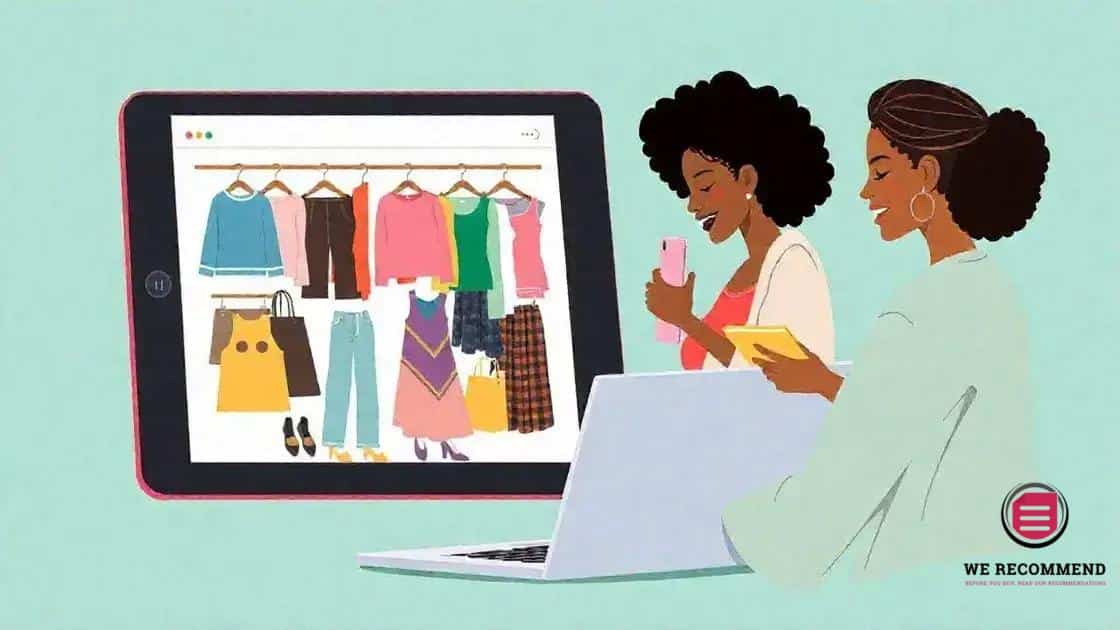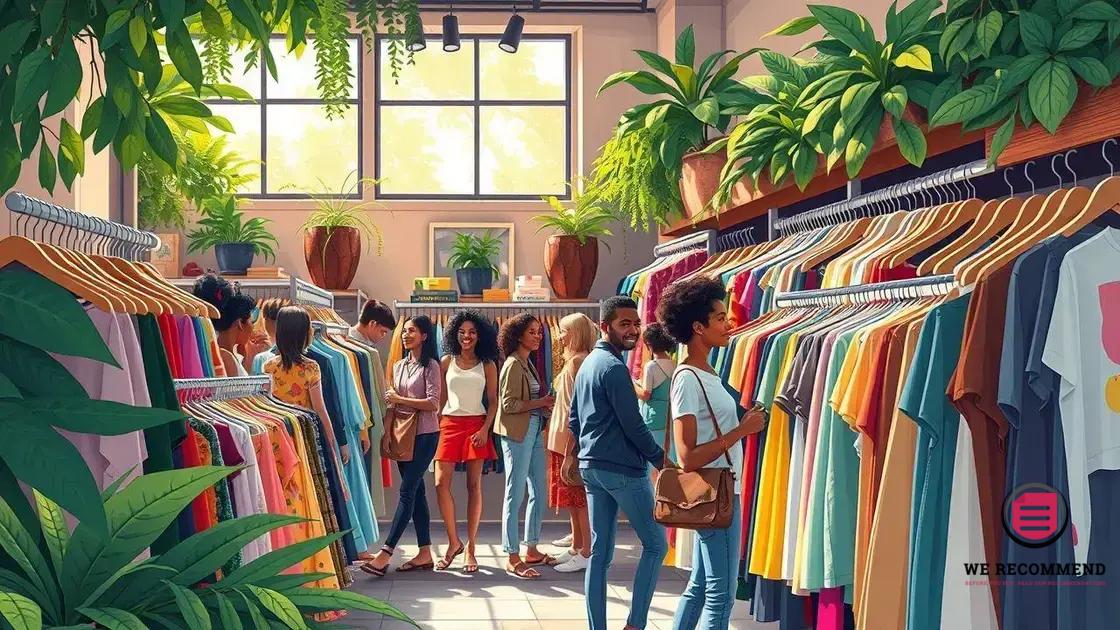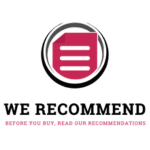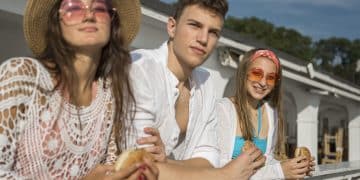ThredUp market expansion: what it means for sustainability

Anúncios
ThredUp is a leader in sustainable fashion, empowering consumers to buy and sell secondhand clothing, thereby promoting a circular economy and reducing waste in the fashion industry.
ThredUp market expansion is a hot topic in the sustainable fashion scene. Have you ever considered how expanding one company can influence entire industries? Let’s dive into what’s changing.
Anúncios
Understanding ThredUp’s business model
Understanding ThredUp‘s business model is crucial for grasping its impact on the sustainable fashion industry. ThredUp operates as an online consignment store, where consumers can buy and sell secondhand clothing.
Anúncios
Shoppers find significant savings on quality clothing while sellers declutter their wardrobes and earn money. This model promotes sustainability by extending the life cycle of garments.
Key Elements of ThredUp’s Business Model
1. **Sourcing Products**: ThredUp sources high-quality secondhand clothing from individuals who send in their items. This allows for a wide variety of products and brands.
2. **Quality Control**: Each item undergoes a strict quality assessment to ensure it meets ThredUp’s standards before being listed for sale. This guarantees that customers receive only the best items.
3. **Access and Convenience**: Through its user-friendly platform, ThredUp offers an easy way for consumers to shop sustainably, attracting a growing market of eco-conscious shoppers.
For further insights into ThredUp’s sustainability efforts, visit ThredUp Sustainability.
Key strategies behind ThredUp’s market expansion
ThredUp’s market expansion is driven by several key strategies that enhance its presence in the sustainable fashion industry. Understanding these strategies can help consumers and investors appreciate the brand’s growth.
One major strategy is expanding its product offerings. By including more categories such as kids’ clothing and accessories, ThredUp attracts a wider audience.
Another crucial approach is leveraging technology to streamline operations. Their platform uses advanced algorithms to optimize inventory management and enhance the shopping experience.
Marketing and Partnership Strategies
ThredUp also focuses heavily on marketing efforts, utilizing social media campaigns and collaborations with influencers to reach new customers.
Partnerships with major retail brands allow ThredUp to access different markets, enhancing visibility and credibility.
For more details about their strategies, visit Business of Fashion.
Impact of ThredUp on the secondhand market
ThredUp has significantly influenced the secondhand market, paving the way for new trends in sustainable fashion. By providing a user-friendly platform, it encourages more people to consider buying secondhand clothes.
This shift has helped to normalize the idea of purchasing used items, making it less stigmatized and more mainstream. ThredUp’s success showcases how embracing sustainability can attract a diverse consumer base.
Driving Growth in the Secondhand Market
As ThredUp expands, it also impacts local thrift shops and resale businesses. Here are some effects:
- Increased interest in secondhand shopping overall, leading to higher sales in the market.
- Encouraging consumers to rethink their purchasing habits, focusing on sustainability.
- Driving innovation within the industry as traditional brands adapt to this growing trend.
Learn more about the overall impact of secondhand shopping on the fashion industry by visiting Refinery29.
Consumer trends driving ThredUp’s growth

Consumer trends play a significant role in driving ThredUp’s growth in the secondhand market. As awareness of sustainable fashion rises, more shoppers are seeking eco-friendly alternatives, making ThredUp a preferred choice.
One major trend is the growing desire for sustainability. Many consumers are becoming more conscious of their environmental impact and are looking for ways to reduce waste.
The convenience of online shopping also fuels ThredUp’s popularity. Customers appreciate the ability to browse a wide selection of secondhand items from the comfort of their homes.
Key Consumer Preferences
Some consumer preferences contributing to ThredUp’s success include:
- A preference for budget-friendly options, allowing shoppers to find high-quality goods at lower prices.
- An interest in unique and vintage items, which secondhand shopping easily provides.
- A shift toward transparency in fashion, as consumers want to know the story behind what they buy.
To explore more about consumer trends in secondhand shopping, visit NRP Group.
How sustainable practices influence ThredUp
Sustainable practices are at the heart of ThredUp‘s business model, greatly influencing its success in the secondhand market. The company is committed to reducing waste and promoting a circular economy.
By encouraging consumers to buy and sell secondhand clothing, ThredUp helps to prolong the lifecycle of garments, which reduces the need for new clothing production.
Moreover, ThredUp’s rigorous quality control ensures that only the best items are sold, maintaining a high standard while minimizing environmental impact.
Key Sustainable Practices
Some practices that illustrate ThredUp’s commitment to sustainability include:
- Using eco-friendly packaging materials to reduce plastic waste.
- Implementing recycling programs for unsellable items to prevent them from ending up in landfills.
- Partnering with organizations to promote sustainable fashion education.
To learn more about sustainable practices in fashion, check out the resources available at The Efficiency Project.
Challenges faced by ThredUp in new markets
ThredUp faces several challenges when entering new markets, which can impact its growth potential. Understanding these challenges provides insight into the complexities of expanding a business in the resale sector.
One major challenge is increasing competition. As demand for secondhand clothing grows, more companies are entering the market, making it tougher to stand out.
Logistical issues also arise when expanding into new regions. ThredUp must manage reliable shipping, returns, and inventory, which can strain operations.
Market Adaptation Challenges
Additionally, adapting to regional consumer preferences is crucial. ThredUp must consider:
- The varying attitudes towards secondhand shopping in different cultures.
- Differences in style preferences and popular brands among consumers.
- Legal and regulatory requirements that may differ by location.
To learn more about the challenges and dynamics of entering new markets, visit Forbes.
ThredUp’s relationship with investors
ThredUp’s relationship with investors is crucial for its growth strategy and market expansion. Investors play a key role in providing the necessary capital to help ThredUp scale its operations.
As a sustainable fashion platform, ThredUp attracts investors who are interested in ethical and environmentally friendly businesses. This alignment of values strengthens ThredUp’s position in the investment community.
Key Aspects of ThredUp’s Investor Relations
Some important aspects of ThredUp’s relationship with investors include:
- Regular communication and transparency about business performance and growth plans.
- Engaging with socially responsible investors who support sustainability initiatives.
- Utilizing funding to enhance technology, logistics, and marketing efforts, ensuring continued growth.
For more details on ThredUp’s financial strategies and investor insights, visit ThredUp’s Investor Page.
Future outlook for ThredUp and sustainability

The future outlook for ThredUp is promising, especially as sustainability becomes a priority for consumers. With increasing awareness of environmental issues, more people are looking for sustainable fashion options.
ThredUp’s business model aligns well with this trend, offering a platform for secondhand clothing that minimizes waste. This positions ThredUp as a leader in the circular economy.
Key Opportunities Ahead
Several factors can drive ThredUp’s growth in the coming years:
- The expansion of its product lines to include more categories and demographics, such as athletic wear.
- Growing partnerships with eco-conscious brands that align with ThredUp’s mission.
- Investments in technology to enhance user experience and streamline operations.
For insights on the future of sustainable fashion and ThredUp’s role, visit GreenBiz.
In summary, the future of ThredUp and sustainable fashion
ThredUp is well-positioned to thrive as the demand for sustainable fashion increases.
By focusing on its core values and expanding its offerings, ThredUp can attract more consumers who prioritize eco-friendly options.
With the right investments in technology and partnerships, ThredUp can lead the way in the secondhand market.
Sustainable practices are no longer a choice; they are essential for businesses today. ThredUp’s commitment to sustainability not only benefits the planet but also enhances its market relevance.
Overall, ThredUp exemplifies how a strong focus on sustainability can drive growth and success in the modern fashion industry.
FAQ – Frequently Asked Questions about ThredUp and Sustainability
How does ThredUp contribute to sustainable fashion?
ThredUp promotes sustainable fashion by providing a platform for buying and selling secondhand clothing, which reduces waste and encourages a circular economy.
What challenges does ThredUp face in new markets?
ThredUp faces challenges such as increased competition, logistical issues, and the need to adapt to regional consumer preferences when entering new markets.
What are the future opportunities for ThredUp?
Future opportunities for ThredUp include expanding product lines, forming partnerships with eco-conscious brands, and investing in technology to improve customer experience.
How does ThredUp’s relationship with investors affect its growth?
ThredUp’s relationship with investors is vital, providing the necessary funding and support to help expand its operations and enhance sustainable practices.






